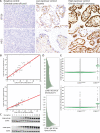Combined CCNE1 high-level amplification and overexpression is associated with unfavourable outcome in tubo-ovarian high-grade serous carcinoma
- PMID: 32391646
- PMCID: PMC7578325
- DOI: 10.1002/cjp2.168
Combined CCNE1 high-level amplification and overexpression is associated with unfavourable outcome in tubo-ovarian high-grade serous carcinoma
Abstract
CCNE1 amplification is a recurrent alteration associated with unfavourable outcome in tubo-ovarian high-grade serous carcinoma (HGSC). We aimed to investigate whether immunohistochemistry (IHC) can be used to identify CCNE1 amplification status and to validate whether CCNE1 high-level amplification and overexpression are prognostic in HGSC. A testing set of 528 HGSC samples stained with two optimised IHC assays (clones EP126 and HE12) was subjected to digital image analysis and visual scoring. DNA and RNA chromogenic in situ hybridisation for CCNE1 were performed. IHC cut-off was determined by receiver operating characteristics (ROC). Survival analyses (endpoint ovarian cancer specific survival) were performed and validated in an independent validation set of 764 HGSC. Finally, combined amplification/expression status was evaluated in cases with complete data (n = 1114). CCNE1 high-level amplification was present in 11.2% of patients in the testing set and 10.2% in the combined cohort. The optimal cut-off for IHC to predict CCNE1 high-level amplification was 60% positive tumour cells with at least 5% strong staining cells (sensitivity 81.6%, specificity 77.4%). CCNE1 high-level amplification and overexpression were associated with survival in the testing and validation set. Combined CCNE1 high-level amplification and overexpression was present in 8.3% of patients, mutually exclusive to germline BRCA1/2 mutation and significantly associated with a higher risk of death in multivariate analysis adjusted for age, stage and cohort (hazard ratio = 1.78, 95 CI% 1.38-2.26, p < 0.0001). CCNE1 high-level amplification combined with overexpression identifies patients with a sufficiently poor prognosis that treatment alternatives are urgently needed. Given that this combination is mutually exclusive to BRCA1/2 germline mutations, a predictive marker for PARP inhibition, CCNE1 high-level amplification combined with overexpression may serve as a negative predictive test for sensitivity to PARP inhibitors.
Keywords: CCNE1; PARP inhibitor; amplification; cyclin E1; high grade serous carcinoma; ovarian cancer; prognosis.
© 2020 The Authors. The Journal of Pathology: Clinical Research published by The Pathological Society of Great Britain and Ireland & John Wiley & Sons Ltd.
Figures



Similar articles
-
CCNE1 and survival of patients with tubo-ovarian high-grade serous carcinoma: An Ovarian Tumor Tissue Analysis consortium study.Cancer. 2023 Mar 1;129(5):697-713. doi: 10.1002/cncr.34582. Epub 2022 Dec 26. Cancer. 2023. PMID: 36572991 Free PMC article.
-
PTEN Deficiency in Tubo-Ovarian High-Grade Serous Carcinoma is Associated with Poor Progression-Free Survival and is Mutually Exclusive with CCNE1 Amplification.Mod Pathol. 2023 May;36(5):100106. doi: 10.1016/j.modpat.2023.100106. Epub 2023 Feb 1. Mod Pathol. 2023. PMID: 36805789
-
Biomarker Assessment of HR Deficiency, Tumor BRCA1/2 Mutations, and CCNE1 Copy Number in Ovarian Cancer: Associations with Clinical Outcome Following Platinum Monotherapy.Mol Cancer Res. 2018 Jul;16(7):1103-1111. doi: 10.1158/1541-7786.MCR-18-0034. Epub 2018 May 3. Mol Cancer Res. 2018. PMID: 29724815
-
Targeting DNA repair: the genome as a potential biomarker.J Pathol. 2018 Apr;244(5):586-597. doi: 10.1002/path.5025. Epub 2018 Feb 10. J Pathol. 2018. PMID: 29282716 Review.
-
The life and times of low-grade serous carcinoma of the ovary.Am Soc Clin Oncol Educ Book. 2013. doi: 10.14694/EdBook_AM.2013.33.e195. Am Soc Clin Oncol Educ Book. 2013. PMID: 23714500 Review.
Cited by
-
The prognostic impact of PD-L1 and CD8 expression in anal cancer patients treated with chemoradiotherapy.Front Oncol. 2022 Oct 7;12:1000263. doi: 10.3389/fonc.2022.1000263. eCollection 2022. Front Oncol. 2022. PMID: 36276142 Free PMC article.
-
Molecular characterization of high-grade serous ovarian cancers occurring in younger and older women.Gynecol Oncol. 2021 May;161(2):545-552. doi: 10.1016/j.ygyno.2021.02.028. Epub 2021 Mar 3. Gynecol Oncol. 2021. PMID: 33674143 Free PMC article.
-
Identification of the prognostic and therapeutic values of cyclin E1 (CCNE1) gene expression in Lung Adenocarcinoma and Lung Squamous Cell Carcinoma: A database mining approach.Heliyon. 2022 Aug 29;8(9):e10367. doi: 10.1016/j.heliyon.2022.e10367. eCollection 2022 Sep. Heliyon. 2022. PMID: 36091953 Free PMC article.
-
Targeted and Shallow Whole-Genome Sequencing Identifies Therapeutic Opportunities in p53abn Endometrial Cancers.Clin Cancer Res. 2024 Jun 3;30(11):2461-2474. doi: 10.1158/1078-0432.CCR-23-3689. Clin Cancer Res. 2024. PMID: 38536067 Free PMC article.
-
MCM3 is a novel proliferation marker associated with longer survival for patients with tubo-ovarian high-grade serous carcinoma.Virchows Arch. 2022 Apr;480(4):855-871. doi: 10.1007/s00428-021-03232-0. Epub 2021 Nov 15. Virchows Arch. 2022. PMID: 34782936 Free PMC article.
References
Publication types
MeSH terms
Substances
Grants and funding
LinkOut - more resources
Full Text Sources
Medical
Miscellaneous

